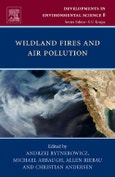The interaction between smoke and air pollution creates a public health challenge. Fuels treatments proposed for National Forests are intended to reduce fuel accumulations and wildfire frequency and severity, as well as to protect property located in the wild land-urban interface. However, prescribed fires produce gases and aerosols that have instantaneous and long-term effects on air quality. If fuels treatment are not conducted, however, then wild land fires become more severe and frequent causing worse public health and wellfare effects. A better understanding of air pollution and smoke interactions is needed in order to protect the public health and allow for socially and ecologically acceptable use of fire as a management tool. Wildland Fires and Air Pollution offers such an understanding and examines innovative wide-scale monitoring efforts (field and remotely sensed), and development of models predicting spatial and temporal distribution of air pollution and smoke resulting from forests fires and other sources.
Please Note: This is an On Demand product, delivery may take up to 11 working days after payment has been received.
Table of Contents
Series Preface.Book Preface.
Introduction.
Section I. General Information and Emissions.
Section II. Ambient Air Quality, Visibility and Human Health -Regional Perspectives.
Section III. Ecological Impacts of Forest Firest and Air Pollution.
Section IV. Management Issues.
Section V. Concluding Section.
LONG TOC
Series Preface (DES Series Editor: Sagar Krupa)
Book Preface (Book Editors: Andrzej Bytnerowicz, Michael Arbaugh, Christian Andersen and Al Riebau)
Introduction (Andrzej Bytnerowicz, Michael Arbaugh, Christian Andersen and Al Riebau)
Section I General Information and Emissions
Impacts of vegetation fire emissions on the environment, human health and security a global perspective (Johann G. Goldammer, Meinrat O. Andreae and Milt Statheropoulos)
Climatic and weather factors affecting fire occurrence and behavior (Francis M. Fujioka, A. Malcolm Gill, Domingos X. Viegas, B. Mike Wotton and Shyh-Chin Chen)
Characterizing sources of forest fire emissions (Roger Ottmar, Ana Isabel Miranda, David Sandberg)
Chemistry of wild land fire emissions (Wei Min Hao and Shawn Urbanski)
Trace-gas emissions from burnings in forests and grasslands with emphasis on Brazil and California (Philip Riggan)
The influence of grassfire on atmospheric environment (Sharon Zhong, C. B. Clements, G. Aumann, P. Potter, S. Goodrick, and X. Bian)
Effects of wild land fire on regional and global carbon stocks in a changing environment (Allen Solomon and Sue Conard)
Airborne remote sensing of wildland fires (Philip Riggan)
Section II Ambient Air Quality, Visibility and Human Health Regional Perspectives
Effects of forest fires on air quality and visibility in North America (Douglas Fox, Roger Ames, Bret Schichtel, William Malm, and Allen Riebau)
Assessment of forest fires impact and emissions in the European Union based on the European Forest Fire Information System (Paulo Barbosa, Ilaria Palumbo, Jan Kucera, Andrea Camia, Jesus San-Miguel, and Guido Schmuck)
Forest fires and air quality issues in southern Europe (Ana Isabel Miranda, Enrico Marchi, Millan Millan, and Marco Ferretti)
Spatial and temporal trends in distribution of forest fires and gaseous emissions in Central and Eastern Europe (Barbara Ubysz, Ryszard Szczygiel, and Tomasz Zawila-Niedzwiecki)
The 2002 mega-fire event in Central Russia: meteorology, optical properties of the atmosphere, air quality, and unexpected consequences (Nataly Ye. Chubarova, Nickolay G. Prilepsky, Alexei N. Rublev, and Allen R. Riebau)
Radioactive emissions from forest fires near Chernobyl, Ukraine (Wei Min Hao et al.)
Effects of Applications of Wildfire on Air Quality in China (John J. Qu, Allen Riebau, and Yongqiang Liu)
Smoke from wildfires and prescribed burning in Australia: health and environmental issues (Tina Bell and Mark Adams)
Estimating contributions of wild land and prescribed fires on diurnal patterns of ozone in Southern Sierra Nevada, California (Haiganoush Preisler, Sharon Zhong, Annie Esperanza, and Julide Koracin)
Section III Ecological Impacts of Forest Fires and Air Pollution
Effects of warmer climate on stress complexes in forests of western North America (Don McKenzie, David Peterson, and Jeremy Littell)
A comparison of the ecological changes in forests caused by fires in California and adjacent Baja California in Mexico (Richard A. Minnich)
Air pollution increases forest susceptibility to wildfires in southern California (Nancy E. Grulke, Richard A. Minnich, Timothy Paine, Alex Dunn, and Deborah Chavez)
Wildfire effects on forest carbon and nutrient budgets and water quality in Sierran forests (Dale W. Johnson, J.D. Murphy, W.W. Miller, and R.F. Walker)
Spatial analysis of critical load exceedances, including the effects of fire, on mixed conifer forests in southern California (Benjamin S. Gimeno, Mark E. Fenn, Joan Breiner, Andrzej Bytnerowicz, and Dale W. Johnson)
Interactive effects of wild land fires and air pollution on forests and other ecosystems a synthesis (Nancy Grulke)
Section IV Management Issues
Managing smoke from wildfires and prescribed burning in southern Australia (Alan Wain, Graham Mills, Lachlan McCaw, and Tim Brown)
Real-Time Smoke Prediction Systems applicable for land management (Susan M. O'Neill, N. Narasimhan Larkin, Jeanne Hoadley, Graham Mills, Joseph K. Vaughan, and Roland Draxler)
Managing forests affected by air pollution, climate change and altered fire regimes near urban areas (Michael Arbaugh, Trent Procter, and Annie Esperanza)
V. Concluding Section
Integrating forest fires and air quality research needs and recommendations (Andrzej Bytnerowicz, Michael Arbaugh, Christian Andersen, and Allen Riebau)








